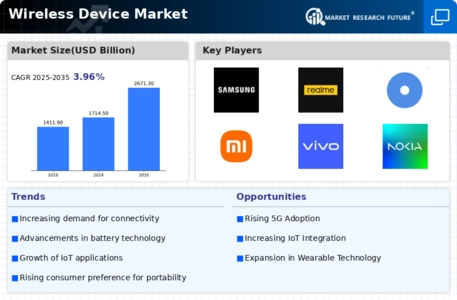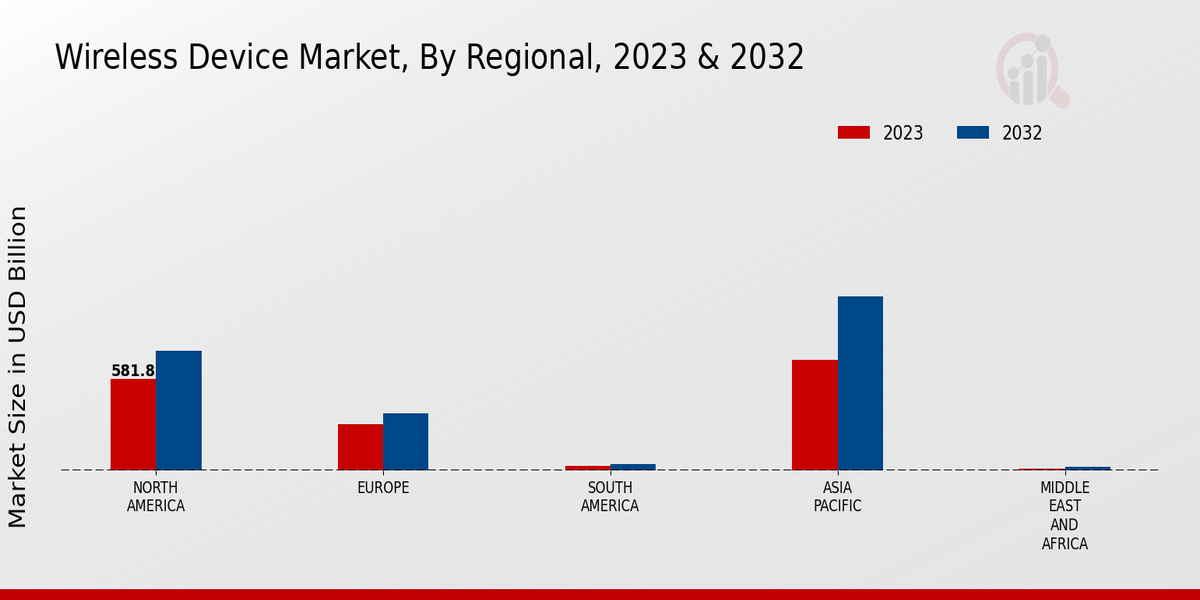Technological Advancements
Technological advancements play a pivotal role in shaping the Global Wireless Device Market Industry. Innovations in wireless communication technologies, including the rollout of 5G networks, are expected to revolutionize the market landscape. These advancements not only enhance data transfer speeds but also improve network reliability, which is crucial for the growing number of connected devices. As a result, the market is anticipated to grow at a CAGR of 4.11% from 2025 to 2035, potentially reaching 2671.3 USD Billion by 2035. This trajectory indicates a robust demand for advanced wireless devices that can leverage these technologies to provide superior user experiences.
Rising Demand for Connectivity
The Global Wireless Device Market Industry experiences a notable surge in demand for connectivity solutions. As individuals and businesses increasingly rely on wireless technology for communication, entertainment, and productivity, the market is projected to reach 1714.5 USD Billion in 2024. This growth is driven by the proliferation of smartphones, tablets, and IoT devices, which facilitate seamless connectivity. Furthermore, advancements in wireless technologies, such as 5G, enhance user experiences and enable new applications, thereby expanding the market's reach. The increasing adoption of smart home devices and wearables further underscores the necessity for robust wireless connectivity.
Increased Adoption of IoT Devices
The Global Wireless Device Market Industry is significantly influenced by the increased adoption of Internet of Things (IoT) devices across various sectors. Industries such as healthcare, agriculture, and manufacturing are integrating IoT solutions to enhance operational efficiency and data-driven decision-making. This trend is expected to propel the market as more devices become interconnected, requiring reliable wireless communication. The proliferation of smart sensors and devices is indicative of this shift, with businesses recognizing the value of real-time data. Consequently, the market's growth is supported by the need for advanced wireless infrastructure to accommodate the influx of IoT devices.
Growing Consumer Electronics Market
The Global Wireless Device Market Industry is closely linked to the expanding consumer electronics market. As consumers increasingly prioritize wireless devices for their convenience and functionality, the demand for smartphones, laptops, and wearables continues to rise. This trend is evident in the growing sales figures for wireless headphones and smartwatches, which have become essential accessories for modern consumers. The market's growth trajectory reflects this consumer preference, with projections indicating a substantial increase in revenue. The integration of wireless technology into everyday devices enhances user experiences, thereby driving further adoption and investment in the wireless device sector.
Market Trends and Growth Projections
The Global Wireless Device Market Industry is characterized by various trends and growth projections that indicate a dynamic landscape. The market is expected to evolve with the increasing integration of artificial intelligence and machine learning in wireless devices, enhancing their capabilities. Additionally, the shift towards sustainable and energy-efficient technologies is gaining traction, influencing consumer preferences. As the market adapts to these trends, it is poised for substantial growth, with projections suggesting a potential market size of 2671.3 USD Billion by 2035. These trends reflect the industry's responsiveness to changing consumer demands and technological advancements.
Government Initiatives and Investments
Government initiatives and investments in wireless infrastructure significantly impact the Global Wireless Device Market Industry. Many governments are actively promoting the development of 5G networks and other wireless technologies to enhance national connectivity and stimulate economic growth. These initiatives often include funding for research and development, as well as incentives for companies to innovate in the wireless space. Such support is likely to accelerate the deployment of advanced wireless solutions, fostering a conducive environment for market expansion. As governments recognize the strategic importance of wireless technology, their involvement is expected to drive substantial growth in the industry.
















